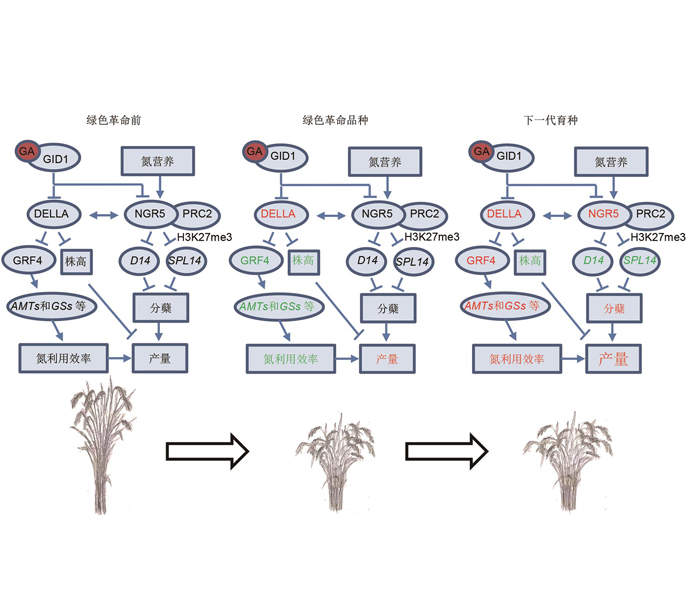

A New Progress of Green Revolution: Epigenetic Modification Dual-regulated by Gibberellin and Nitrogen Supply Contributes to Breeding of High Yield and Nitrogen Use Efficiency Rice
Received date: 2020-01-07
Accepted date: 2020-01-13
Online published: 2020-02-07
The Green Revolution represented by the breeding of semi-dwarf crops greatly promoted agriculture yield, but it also unfortunately led to the problem of low nitrogen use efficiency (NUE). The achievement of Green Revolution was mainly based on modification of gibberellin (GA) metabolic or signaling pathways in crops. A previous study has found that the central regulator of GA signaling pathway DELLA protein negatively regulates NUE through suppressing GRF4, an essential NUE regulator, which provided a resolution for improving NUE of semi-dwarf rice. A recent study further revealed a novel mechanism underlying the crosstalk between GA signaling and nitrogen response. The study revealed that NGR5 is a key gene controlling tiller number changes under different nitrogen conditions, which is inducible by nitrogen. Further investigation established that the NGR5 suppresses branching inhibitory genes, such as D14 and OsSPL14, through nitrogen-dependent recruitment of polycomb repressive complex 2 that promotes histone H3 lysine 27 tri-methylation in the regions habouring the branching suppressors. In addition to be responsive to nitrogen, NGR5 is also negatively regulated by GA and its receptor GID, and overexpression of NGR5 in the semi-dwarf background is thus able to significantly improve rice yields under low nitrogen conditions. This study not only uncovered a new mechanism of GA signaling, but also enlightens the new generation of Green Revolution by breeding high yield crops with enhanced NUE.

Key words: rice; tiller number; nitrogen use efficiency; histone modification
Mei-ling Han,Ru-jiao Tan,Dai-yin Chao . A New Progress of Green Revolution: Epigenetic Modification Dual-regulated by Gibberellin and Nitrogen Supply Contributes to Breeding of High Yield and Nitrogen Use Efficiency Rice[J]. Chinese Bulletin of Botany, 2020 , 55(1) : 5 -8 . DOI: 10.11983/CBB20002
| [1] | Crawford NM, Forde BG (2002). Molecular and developmental biology of inorganic nitrogen nutrition. Arabidopsis Book 1, e0011. |
| [2] | Gooding MJ, Addisu M, Uppal RK, Snape JW, Jones HE (2012). Effect of wheat dwarfing genes on nitrogen-use efficiency. J Agric Sci 150, 3-22. |
| [3] | Guo JH, Liu XJ, Zhang Y, Shen JL, Han WX, Zhang WF, Christie P, Goulding KWT, Vitousek PM, Zhang FS (2010). Significant acidification in major Chinese crop- lands. Science 327, 1008-1010. |
| [4] | Harberd NP, Belfield E, Yasumura Y (2009). The angiosperm gibberellin-GID1-DELLA growth regulatory mechanism: how an "inhibitor of an inhibitor" enables flexible response to fluctuating environments. Plant Cell 21, 1328-1339. |
| [5] | Khush GS (1999). Green Revolution: preparing for the 21st century. Genome 42, 646-655. |
| [6] | Kong WD, Zhu YG, Fu BJ, Han XZ, Zheng L, He JZ (2008). Effect of long-term application of chemical fertilizers on microbial biomass and functional diversity of a black soil. Pedosphere 18, 801-808. |
| [7] | Li S, Tian YH, Wu K, Ye YF, Yu JP, Zhang JQ, Liu Q, Hu MY, Li H, Tong YP, Harberd NP, Fu XD (2018). Modulating plant growth-metabolism coordination for sustainable agriculture. Nature 560, 595-600. |
| [8] | Murase K, Hirano Y, Sun TP, Hakoshima T (2008). Gibberellin-induced DELLA recognition by the gibberellin receptor GID1. Nature 456, 459-463. |
| [9] | Peng JR, Richards DE, Hartley NM, Murphy GP, Devos KM, Flintham JE, Beales J, Fish LJ, Worland AJ, Pe- lica F, Sudhakar D, Christou P, Snape JW, Gale MD, Harberd NP (1999). 'Green Revolution' genes encode mutant gibberellin response modulators. Nature 400, 256-261. |
| [10] | Pingali PL (2012). Green Revolution: impacts, limits, and the path ahead. Proc Natl Acad Sci USA 109, 12302-12308. |
| [11] | Sasaki A, Ashikari M, Ueguchi-Tanaka M, Itoh H, Nishimura A, Swapan D, Ishiyama K, Saito T, Kobayashi M, Khush GS, Kitano H, Matsuoka M (2002). Green Revolution: a mutant gibberellin-synthesis gene in rice. Nature 416, 701-702. |
| [12] | Sasaki A, Itoh H, Gomi K, Ueguchi-Tanaka M, Ishiyama K, Kobayashi M, Jeong DH, An G, Kitano H, Ashikari M, Matsuoka M (2003). Accumulation of phosphorylated repressor for gibberellin signaling in an F-box mutant. Science 299, 1896-1898. |
| [13] | Shimada A, Ueguchi-Tanaka M, Nakatsu T, Nakajima M, Naoe Y, Ohmiya H, Kato H, Matsuoka M (2008). Structural basis for gibberellin recognition by its receptor GID1. Nature 456, 520-523. |
| [14] | Spielmeyer W, Ellis MH, Chandler PM (2002). Semidwarf (sd-1), "green revolution" rice, contains a defective gibberellin 20-oxidase gene. Proc Natl Acad Sci USA 99, 9043-9048. |
| [15] | Wu K, Wang SS, Song WZ, Zhang JQ, Wang Y, Liu Q, Yu JP, Ye YF, Li S, Chen JF, Zhao Y, Wang J, Wu XK, Wang MY, Zhang YJ, Liu BM, Wu YJ, Harberd NP, Fu XD (2020). Enhanced sustainable Green Revolution yield via nitrogen-responsive chromatin modulation in rice. Science 367, eaaz2046. |
| [16] | Zhang CH, Gao LF, Sun JQ, Jia JZ, Ren ZL (2014). Haplotype variation of Green Revolution gene Rht-D1 during wheat domestication and improvement. J Integr Plant Biol 56, 774-780. |
/
| 〈 |
|
〉 |